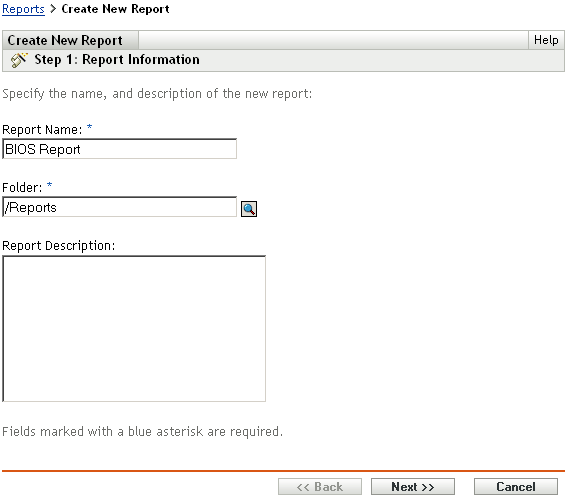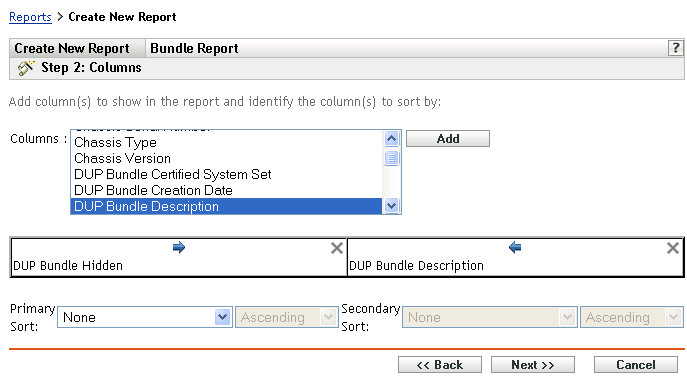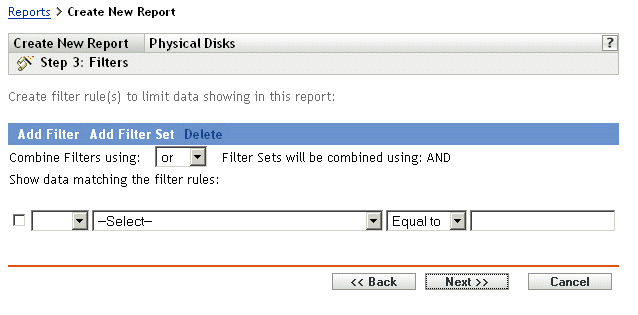42.2 Creating a Report
ZENworks allows you to define the devices for which the system generates report data, and to customize how the information is displayed. After you create the report, you can generate the report and view or print it in formats such as XML, HTML, or CSV (comma-separated values). You can also create new folders to store multiple reports that you can run simultaneously.
-
In the ZENworks Control Center, click the tab.
-
Click .

-
Use the Report Information page to specify the following information:
Report name: Specify a report name.
Folder: Specify the folder name, or browse to locate the folder in which you want to store the report. When you browse to locate a folder, the system displays the Select Folder dialog box. After you locate the desired folder, click the icon to select the folder, then click .
Report description: Specify a report description. The system displays this description beneath the report name in the generated report.
-
Click .
-
Use the Columns page to add and sort the columns that you want to display on the report.

Columns: Select a column, then click . You can select a group of items by holding the Shift key and clicking the first and last items in the group, or you can select several items by holding the Ctrl key and clicking each item. The system displays the items as you add them. Use the ZENworks interface to sort or remove the columns.
The column in Bundle Reports displays True if any package updates are assigned to a device through bundles but are not yet installed. It displays False after these updates are installed and the software inventory is updated to the server.
Primary and secondary sort: Use the drop-down menus to specify a primary and secondary sort, if needed. You can sort by a column in ascending or descending order.
-
Click .

Use the Filters page to create filter rules to manipulate the amount of queried data you want to display on the report. Filter sets enable you to create sets of individual filters, and evaluate them with another set of individual filters. The system uses Boolean logic (And, Or, and Not operators) that determines how to process filters and filter sets. Individual filters can be grouped by And or Or based on how you select the conjunction operator. If you select And to combine filters within filter sets, then the filter sets will be Or, and vice versa. Filter sets can be grouped using Or or And. If you have multiple conditions that must be met, group them using individual filter sets with an And condition.
For example, you can add a filter to report inventory data for a particular , then add a second filter to further limit (or expand) the results, such as the . You then might add another filter and use the Not operator to eliminate a certain value from the search.
-
Click to create a filter.
Use the drop-down menu to specify whether to combine filters using And or Or. This selection also controls how the system combines filter sets. Depending on the item you select for the filter, ZENworks provides a variety of filtering criteria, such as:
-
Alphanumeric (equal to / contains)
-
Date and time (before, after, relative, non-existent)
-
Size (<, >, =, and so on)
-
True/false
-
Has/doesn’t have
For example, the following filter sets return all devices with 10 GB hard disk drives containing less than 2 GB of free space:

-
-
Click to create a new set of filters, then click to add filters to the new set.
For example, the following filter set returns all devices with more than 2 GB of free space that are not made by the specified manufacturer:

New filters are always added to the newest filter set.
To delete a filter, select a filter’s check box, then click .
-
Click .
Use the Summary page to review the report information.
-
Click to create the new report, then click on the Results page to return to the Reports page.
Novell recommends that you use the column only in conjunction with other message and device columns and filters. If you add other types of columns or filters, the message displayed in this column may be inaccurate. Known exceptions of device columns and filters that also cause this inaccuracy are:
-
Device Code Page
-
Device Virtual Memory
-
Device Visible Memory
42.2.1 Using Templates to Create Dell Reports
ZENworks Linux Management includes two report templates you can use to create reports:
-
Devices Not Having Valid Dell Update Package Bundles
-
Devices Not Having Valid RPM Package Bundles
Because these are templates, you must modify them before you can generate a report.
-
In the ZENworks Control Center, click the tab.
-
Click .
-
Click the check box next to the template you want to modify.
-
Click .
-
Specify a name for the report and click .
-
Click the report name you just created.
-
Modify the report. See Section 42.4, Modifying Report Details.
-
Make sure you’ve properly filled out the filter fields. For the Dell Update Package Bundles report, the and fields are required; for the Devices Not Having Valid RPM Package Bundles report, the required fields are and .
-
To generate the report, click Generate. To export the report to HTML, CSV, or XML, see Section 42.6, Exporting Reports.